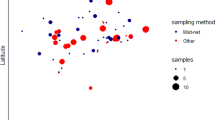Abstract
The multiple insemination of Drosophila subobscura females in nature was studied by the analysis of single female offspring using two highly polymorphic enzyme systems. On qualitative grounds it was found that 23% of these females were inseminated at least twice. The ‘power of detection’ of one enzyme system was estimated using the already known multi-inseminated females detected by the other system. This permitted the true frequency estimation of multi-inseminated females, in nature, which is 0.276 (for 95% confidence limits it ranges from 0.186 to 0.417). In a laboratory experiment it was found that sperm from the second inseminating male displaces the sperm from the first male.
Similar content being viewed by others
References
Anderson W. W., 1974. Frequent multiple insemination in a natural population of D. pseudoobscura. Am. Nat. 108: 709–711.
Begon M., 1976. Dispersal, density and microdistribution in D. subobscura Collin. J. Anim. Ecol. 45: 441–456.
Begon M., Krimbas C. B. & Loukas M., 1980. The genetics of Drosophila subobscura populations. XV. Effective size of a natural population estimated by three independent methods. Heredity 45(3): 335–350.
Christiansen F. B., Frydenberg O. & Simonsen V., 1973. Genetics of Zoarces populations. IV. Selection component analysis of an esterase polymorphism using population samples including mother offspring combinations. Hereditas 73: 291–304.
Cobbs G., 1977. Multiple insemination and male sexual selection in natural populations of D. pseudoobscura. Am. Nat. 111: 651–656.
Craddock E. M. & Johnson W. E., 1978. Multiple insemination in natural populations of D. silvestris. D.I.S. 53: 138.
Dobzhansky Th. & Pavlovsky O., 1967. Repeated mating and sperm mixing in D. pseudoobscura. Am. Nat. 101: 527–533.
Dobzhansky Th., Spassky B. & Tidwell T., 1963. Genetics of natural populations. XXXII. Inbreeding and the mutational and balanced genetic loads in natural populations of D. pseudoobscura. Genetics 48: 361–373.
Fountatou-Vergini J., 1973. Is Drosophila subobscura monogamic? D.I.S. 50: 101.
Fuerst P. A., Pendlebury W. W. & Kidwell J. F., 1973. Propensity for multiple mating in D. melanogaster female. Evolution 27: 265–288.
Gugler H. D., Kaplan W. D. & Kidd K., 1965. The displacement of first-mating by second-mating-sperm in the storage organs of the female. D.I.S. 40: 65.
Kojima K., 1971. Is there a constant fitness for a given genotype? No! Evolution 25: 281–285.
Lefevre G. & Jonsson U. B., 1962. Sperm transfer, storage, displacement, and utilization in D. melanogaster. Genetics 47: 1719–1736.
Loukas M. & Krimbas C. B., 1975. The genetics of D. subobscura populations. V. A study of linkage disequilibrium in natural populations between genes and inversions of the E chromosome. Genetics 80: 331–347.
Loukas M. & Krimbas C. B., 1979. The genetics of D. subobscura populations. X. A study of dispersal. Genetica 50: 127–134.
Loukas M., Krimbas C. B., Mavragani-Tsipidou P. & Kastritsis C. D., 1970. The genetics of D. subobscura populations. VIII. Allozyme loci and their chromosome maps. J. Hered. 70: 17–26.
Loukas M., Tsakas S., Krimbas C. B., Zouros E., Diamantopoulou E. & Alevizos V., 1974. Appendix to the paper of E. Zouros, C. B. Krimbas, S. Tsakas and M. Loukas ‘Genic versus chromosomal variation in natural populations of D. subobseura’. Genetics 78, 1240–1244.
Maynard-Smith J., 1956. Pertility, mating hehaviour and sexual selection in D. subobscura. J. Genet. 54: 261–279.
Maynard-Smith, J., 1975. The theory of evolution. Penguin Books, 3rd edition.
Milkman R. & Zeitler R. R., 1974. Concurrent multiple paternity in nature and laboratory populations of D. melanogaster. Genetics 78: 1191–1193.
Milkman R., Zeitler R. & Layfer L. 1973. Multiple paternity in cage populations. D.I.S. 50: 104.
Petit C. & Ehrman L., 1970. Sexual selection in Drosophila. Evolutionary biology 3: 117–223.
Petit C., Bourgeron P. & Mercot H., 1980. Multiple matings, effective population size and sexual selection in D. melanogaster. Heredity 45(2): 281–292.
Richmond R. C. & Ehrman L., 1974. The incidence of repeated mating in the superspecies, Drosophila paulistorum. Experientia 30: 489–490.
Zouros E., 1969. On the role of female monogamy in the sterilemale technique of insect control. Annis Inst. phytopath. Benaki (Nouvelle Series) 9: 20–29.
Zouros E. & Krimbas C. B., 1970. Frequency of female digamy in a natural population of the olive fruit fly Dacus oleae as found using enzyme polymorphism. Entomologia exp. appl. 13: 1–9.
Author information
Authors and Affiliations
Rights and permissions
About this article
Cite this article
Loukas, M., Vergini, V. & Krimbas, C.B. The genetics of Drosophila subobscura populations XVIII. Multiple insemination and sperm displacement in Drosophila subobscura. Genetica 57, 29–37 (1981). https://doi.org/10.1007/BF00057540
Received:
Accepted:
Issue Date:
DOI: https://doi.org/10.1007/BF00057540




